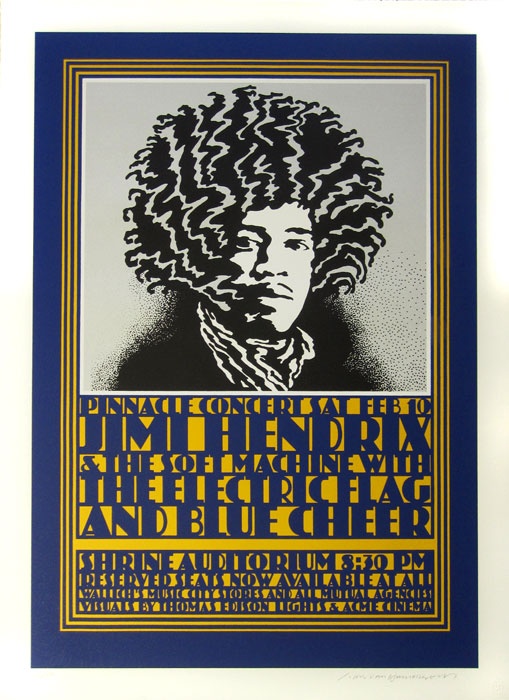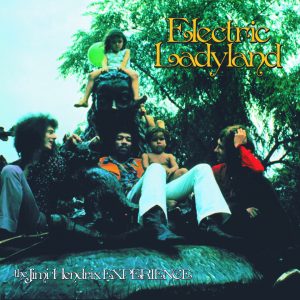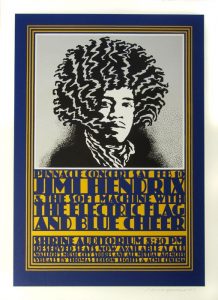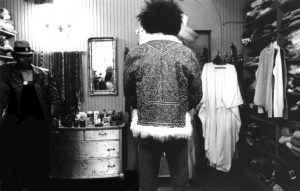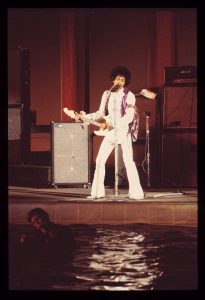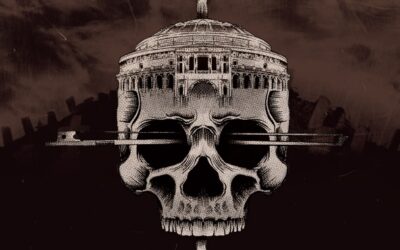50th ANNIVERSARY BOX SET FOR NOVEMBER 9th RELEASE
By Harvey Kubernik c 2018
In celebration of the 50th anniversary of the release of the Jimi Hendrix Experience masterpiece Electric Ladyland, Experience Hendrix, L.L.C. and Legacy Recordings, the catalog division of Sony Music Entertainment, will issue a Deluxe Edition box set on November 9.
Available as a 3CD/1 Blu-ray set or a 6LP/1 Blu-ray set, both packages include the original double album, now newly remastered by Bernie Grundman from the original analog tapes. For the LP set, Grundman prepared an all analog direct to disc vinyl transfer of the album, preserving the authenticity.
Also included is Electric Ladyland: The Early Takes, which presents demos and studio outtakes from this period in Hendrix’s career, plus a new 5.1 surround sound mix of the entire original album by Hendrix’s original engineer Eddie Kramer.
This marks the first and only time this has been done with a Hendrix studio album, and gives listeners the original stereo mixes in uncompressed 24 bit/96 kz high resolution audio.
The Blu-ray also includes the acclaimed, feature length documentary At Last… The Beginning: The Making of Electric Ladyland.
Lastly, Electric Ladyland Deluxe Edition includes a full color, 48-page book containing Jimi’s handwritten lyrics, poem and instructions to his record label, as well as never before published photos from the recording sessions that were shot by Eddie Kramer himself.
In a media release from Experience Hendrix, L.L.C., Kramer discussed the new Electric Ladyland configuration. “I had always dreamed of mixing Electric Ladyland in 5.1 surround sound,” says Kramer, who engineered every Hendrix album made during his life, and produced or co-produced nearly all of his posthumous material.
“It always felt to me as the perfect vehicle for the kind of adventuresome stuff that Jimi and I were trying to do in 1968. The visceral thrill when we completed the first surround mix of ‘Voodoo Child (Slight Return)’ was palpable. It was an overwhelming experience—pun intended. We viewed this song as the surround test and the moment I heard it I flashed back on those moments when Jimi and I were mixing the stereo album, laughing at our attempts to find that ‘elusive’ sound.”
The Blu-ray for Electric Ladyland Deluxe Edition will contain these 5.1 surround sound mixes – a first for any studio album in the Hendrix canon.
The new cover art – a Linda (McCartney) Eastman photograph of the band and children at the statue of Alice In Wonderland in New York’s Central Park – was Hendrix’s own choice of imagery for the album’s cover image.
The shot was relegated to the inside of the U.S. version on Reprise Records, printed in black and white. The U.K. version of the album released by Track Records didn’t include the photo at all, and instead featured a gatefold photo of 19 naked women, which Hendrix famously abhorred.
For the first time ever, the Linda Eastman photo, in full color, will grace the cover of Electric Ladyland, true to Jimi Hendrix’s original vision.
The third album by the Jimi Hendrix Experience, Electric Ladyland was the last Hendrix studio album to have been released during the guitar icon’s lifetime and reflects his meticulous involvement in every facet of its creation.
Originally released on October 16, 1968, Electric Ladyland is the source of such legendary Hendrix tracks as “All Along The Watchtower,” “Voodoo Child (Slight Return),” “Crosstown Traffic,” and “Burning of the Midnight Lamp.”
It is viewed as the most fully realized, cohesive project of his entire career. The only Hendrix album to have hit #1 on the Billboard charts, it is, indisputably, the crowning achievement of The Jimi Hendrix Experience and underscored Hendrix’s abilities as singer, songwriter, guitarist, and producer. It remains his most popular selling album outside the U.S., outpacing the guitarist’s groundbreaking debut LP Are You Experienced.
Notable for being the first album produced and directed by Jimi Hendrix, Electric Ladyland was largely recorded after Hendrix split from Chas Chandler – the former member of the Animals who found Hendrix in New York and brought him to the U.K., co-managing his career and producing the first two Experience albums.
There is also the introduction of outside players, namely Steve Winwood, Chris Wood and Dave Mason of Traffic, Jack Casady of Jefferson Airplane (bass on “Voodoo Chile”), and Hendrix’s own future Band of Gypsys band mate Buddy Miles (drums on “Rainy Day, Dream Away” and “Still Raining, Still Dreaming”).
As a result of the growing tension between Hendrix and Experience bassist Noel Redding (who parted ways the following year), Hendrix took it upon himself to play bass on most of the songs, including the cover of Bob Dylan’s “All Along the Watchtower,” the only Jimi Hendrix Experience single to reach Billboard’s top 20.
Widely considered one of the greatest interpretations ever recorded, Dylan professed in 1995 that Hendrix “found things that other people wouldn’t think of finding in there. He probably improved upon it by the spaces he was using.”
By 1974, Dylan demonstrated the ultimate show of respect when he began using Hendrix’s template to perform his own song. On a February 9, 1974 tour stop at the Seattle Center Coliseum with The Band, Dylan in a rare stage comment proclaimed, “great to be in Seattle, birthplace of Jimi Hendrix!”
Jimi was obsessed by Dylan’s Highway 61 Revisited. Hendrix and his band mates performed “Like a Rolling Stone” from that LP at the June 1967 Monterey International Pop Festival. Hendrix even wore his hair 1966 Blonde on Blonde Dylan style.
The JHE recorded Dylan’s 1965 single, “Please Crawl Out Your Window?” at a October 17, 1967 BBC Radio taping, and included it in their May 1968 Filmore East appearance.
Hendrix also loved Dylan’s John Wesley Harding. In 1969 Jimi relocated to Woodstock, New York, where Dylan and his family were residing. Hendrix subsequently recorded “Drifter’s Escape” from JWH in 1970 at Electric Lady Studios.
In 2011 I interviewed Janie Hendrix, CEO of Experience Hendrix, L.L.C.
We talked about the Jimi Hendrix and Bob Dylan mutual appreciation society.
“He really loved the lyrics of Bob Dylan. And he was one person who I met who really admired Jimi.
“I’ll start here. Ten years after Jimi died my dad got a phone call. I had come home from college and he said, ‘You’ll never believe who called today.’ ‘Who?’ ‘Bob Zimmerman. Bob Dylan.’ I did the same thing. ‘What did he want? ‘Well, he called, and said, first of all, I want to give you my condolences for Jimi passing. And I know you’ll find this odd that its ten years later and I’m finally calling but I’ve picked up the phone so many times in the last decade and I just couldn’t bring myself to call you and talk to you. But Jimi was more than somebody that admired my music. I admired him. He was a friend. And it just hurt, extremely when he died. And just wanted to pick up the phone to call you and give my condolences.’
“’Wow…Of course my dad was very emotional and it made him cry. ‘Why thank you for calling.’ And Dylan said, ‘the next time I am in Seattle I’d like you to come to the concert.’ ‘OK.’
“So a few years later, Bob Dylan came to town and he invited us to the show and we went backstage. And, here is my dad, late seventies, and a little camera on his wrist and he’s got arthritis and not walking very well. But we get backstage at The Paramount in the green room.
“And he’s reaching for his camera, and Bob Dylan doesn’t like to take pictures, so his body guards almost attack my dad (laughs). ‘I’m sorry. I would like to have a picture with you.’ And Bob Dylan had on his sip up hoodie and pulled the hood off and said, ‘It’s OK. Come on.’ So I took some pictures of them. I mentioned ‘Jimi always said he loved your lyrics.’ And he said, ‘I loved his guitar playing.’
“At the concert we also had been given seats and chairs at the side of the stage and the guitar player nods at me and I nudged my dad as they were getting ready to play ‘All Along The Watch Tower.’ And Bob Dylan made it a point to say, ‘I do it the way Jimi did it to honor Jimi. Even though it was a song I wrote.’”
Electric Ladyland: The Early Takes consists of demos for song ideas Hendrix recorded himself on a Teac reel-to-reel tape machine in early 1968, as well as early sessions at Sound Center and the Record Plant in New York.
Previously unreleased versions of “Angel Caterina” and “Little Miss Strange” have guest appearances from Buddy Miles and Stephen Stills. “Long Hot Summer” features Hendrix and Mitch Mitchell with Al Kooper on piano, and “At Last . . . the Beginning” is an early version of what would become “…And the Gods Made Love.”
Jimi’s demos, recorded in March 1968 while he resided at the Drake Hotel in Manhattan included formative renditions of such classic songs as “Voodoo Chile” and “Gypsy Eyes,” as well as fascinating sketches of songs such as “Angel” and “My Friend” which, despite their quality, did not make the album.
At Last… The Beginning: The Making of Electric Ladyland documents the creation of the legendary double album. Some of Jimi’s closest associates are seen on screen discussing their first-hand recollections of Hendrix and the project including JHE bassist Noel Redding, drummer Mitch Mitchell, manager Chas Chandler; Buddy Miles, Jack Casady, Steve Winwood, Dave Mason and others who participated in the Electric Ladyland sessions.
One of the highlights of the program includes demonstrations by Eddie Kramer, who discusses the techniques Hendrix, Mitchell and Redding employed in recording the album, playing some of the original multitrack tapes to illustrate the process. At Last… The Beginning: The Making of Electric Ladyland is the definitive telling of the story.
The accompanying 48-page full-color book contains essays by music critic David Fricke and producer John McDermott. It is filled with detailed recording information and unpublished photos, including many taken by Eddie Kramer during the recording of the album. Fans get a rare look at Hendrix’s handwritten lyrics and instructions to his label Warner Bros. for the album, drawn from his personal notebook, as well as original Warner Bros. internal memos and alternate artwork for the album.
Also implemented in this 2018 retail issue is Jimi Hendrix Experience: Live At the Hollywood Bowl 9/14/68, part of Experience Hendrix’s Dagger Records official bootleg series, is another exclusive component. The never before released recording captures the band and the mounting excitement that took place just weeks before the release of Electric Ladyland.
When 1968 began, the world and Hollywood were eagerly waiting for the Jimi Hendrix Experience to perform locally again as well as the long-awaited Electic Ladyland due that October.
On February 10, ’68 Hendrix scheduled a Pinnacle-produced concert in downtown Los Angeles at the Shrine Auditorium. One of the promoters of the visionary Pinnacle staff was legendary artist and graphic designer John Van Hamersveld, who created the iconic poster for the show.
“As the making of the classic Hendrix poster neared completion, I knew I had to get the drawing done,” explained Van Hamersveld to me in a 2011 interview.
“There were a couple of starts, but on the morning of December 28, 1967, as I sat down at the drawing table inside my second- story Coronado Street Studio, I started a new kind of drawing for the poster.
“The morning light came in through the large front window of the studio corner, casting the light across the table, spreading over the paper. With my black Pentel pen in hand, I began drawing from the image in my mind the portraiture of the head of Jimi Hendrix with wired hair, styled in his fashionable coiffure from London, like the Cream. I put the drawing in a drawer for a week to think about it.
“My partners Sepp and Marc had booked Jimi Hendrix and the Experience for the Pinnacle event at the Shrine Auditorium. The drawing was incorporated into the design of a Shrine Auditorium event to promote the famous February show. The poster was distributed locally and then nationally, and later worldwide.
“Jimi had charisma on stage. He was a nice guy. We went shopping on Sunset Blvd. with Buddy Miles at De Voss, a clothing boutique.”
Junior high school student and writer, Marina Muhlfriedel, attended this landmark Hendrix recital.
“That foggy February night, I was reborn at the Los Angeles Shrine Auditorium. Baptized in a torrent of rock ‘n’ roll to commune with a
guitar-wielding sorcerer who, somewhere between genial conversation and electrifying vocal lines, revealed his true intent. To seduce us, seduce me, into some conjured cosmos where all else slipped away. Just before closing my eyes, I thought I caught a glint in Jimi’s and instantly felt the onslaught of sound wash through each cell of my being.
“Earlier that day, I didn’t know what, ‘Are You Experienced’ meant to ask. But, by the end of the show, back in the world, at age 14, I had no doubt I indeed was.”
While in Southern California on February 13, 1968, the Jimi Hendrix Experience did a concert at the Ackerman Union Ballroom on the campus of UCLA (University of California Los Angeles).
Jimi was certainly familiar with UCLA, and happy to accept this booking in Westwood just eight months after his triumph at the June 1967 Monterey International Pop Festival, a July 2, ’67 Whisky a Go Go gig and a Hollywood Bowl August 18, ‘67 date opening for the Mamas and Papas.
In 1958, West Coast Seattle Boy James Marshall Hendrix as a 15 year old teenager was captivated by the college football teams of the Pacific Coast Conference league and drew four illustrations of Pac-8 Oregon, USC, California, and UCLA players in their school colors. The drawings are on display at the Rock and Roll Hall of Fame in Cleveland, Ohio.
“On January 11, 1967 I saw the Jimi Hendrix Experience debut at The Bag O’Nails in London along with my brother,” enthused David Kessel, musician and CEO of cavehollywood.com. “They did two sets. Brian Jones, Eric Burdon, Eric Clapton, Lulu, Donovan, Paul McCartney, Ringo Starr, Bill Wyman, and Pete Townshend were in the room. Various technical and equipment people were also on hand, including a guitar effects maker, Roger Mayer, who would later create some effects pedals for Jimi.
“Jimi was just showing up as this maniac, psychedelic, mod, blues rock, guitar player. The band was a big surprise and blew away the star studded rock crowd of England’s finest. We were teenagers, and got in because our dad (guitarist Barney Kessel) had a record deal with Polydor.
“The whole act was something heretofore non-existent. It was truly like aliens had landed. I mean Mitch Mitchell was a jazz drummer and Noel Redding was a converted guitar player, playing bass with this wild man. An American black guy playing with these pasty white English guys in mod outfits. I myself am a guitar player who plays bass in my trio band Willapa. It’s interesting to move the chemistry around to find the right groove.
“The brilliant Chas Chandler productions of Are You Experienced and Axis Bold As Love encapsulate this new musical madness in a tight pop format.
“When Electric Ladyland came out you could see the rocket ship was going to a whole new world. Jimi was producing and spending lots of time in the studio experimenting. Look at ‘All Along The Watchtower,’ a Dylan song and ‘Voodoo Child Slight Return.’ Some pretty out there powerful renderings, going in different directions.”
“I am of true belief that Jimi Hendrix (armed with his Fender Stratocaster) was sent from another planet to wreak havoc on this Earth,” exclaimed Gene Aguilera, East L.A. music historian and boxing book author, Latino Boxing in Southern California.
“Hearing that Hendrix’s third album, Electric Ladyland, was hailed as the next musical bible, I rushed to buy it at the local White Front store in East L.A.
“As I dropped the needle on ‘…As the Gods Made Love,’ I felt a strange voodoo take over. There was a feeling of slight panic in the room as my speakers melted into volcanic molten matter while my ears were reduced to mush. An old hobby of mine was to cherry-pick Hendrix’s early influences on this tour-de-force double LP: everything from Curtis Mayfield to Dylan to Earl King. I first listened to Electric Ladyland as a 15-year old kid in 1968 with astonishment and wonder for such a beautiful piece-of-work. Now I find myself 50 years on, still listening to the same record and still feeling the same way.”
“It is hard to believe in our identity-addled age that I was never conscious of Jimi as a man of ‘color,’ beholden to a politically correct set of beliefs and behaviors,” offered author Kenneth Kubernik. “Unlike, say, Motown or Stax artists, who celebrated a vision of young America steppin’ out to an irresistible black backbeat, Hendrix appeared a world apart, more a visitor from a benevolent beyond, who great gift was to transport the listener to a land filled with zebras, moonbeams and fairy tales. Jimi’s ‘blackness’ was just one shade of his painterly palette; like Matisse, a kind of musical Fauvist – wild beast – who confounded expectations with his command of the building blocks of sound. Jimi was a rainbow with attitude.
“Electric Ladyland is Jimi’s defining work, his ‘Dance,’ a showcase of every hue in his inventory. We’ve all got our favorites but it’s the cobalt blue din of ‘Voodoo Chile’ that guts me. The rapport between Jimi and the equally precocious Stevie Winwood – the Amadeus of ’60s English rock – is alchemical, those cascades of loamy organ swirls freeing Jimi to till the field with his knife edge. It still makes me shudder, fifty years on.”
“I can’t remember where in L.A. I first bought the album, but I recall paying extra for the Track/U.K. edition, thinking how cool it was that I had the ‘censored’ cover,” revealed KEBF-FM deejay Dr. James Cushing. “I was completely unaware that Jimi felt insulted by that cover because he thought the cheesecake element betrayed the company’s lack of confidence in his music.
“Also, I just reread John Perry’s very thoughtful and well-researched 2004 book on the album in the Continuum 33-1/3 series (Volume 8), and his coverage is so detailed and contextually nuanced that I really can’t add much to what he writes there.
“His conclusion is that Electric Ladyland is one of the greatest double albums in rock, which means, at one level, that it continues to deserve serious attention as a work of art. I think I might be able to add something here about The Double Album as a historical phenomenon: a generation’s conscious sign of artistic seriousness.
“In 1968, the rock audience started taking itself and its music seriously. Two major signs of this new seriousness were the flourishing of Rolling Stone magazine and the rock audience’s acceptance of the double album — a big, expensive package, promising by its very length to deliver something with ambition behind it, an artistic statement in the way a 2-LP opera or symphony recording was an artistic statement.
“When jazz or popular artists wanted to make a bid for seriousness, they would make 2-LP concert albums — Benny Goodman, Judy Garland, and Harry Belafonte all made famous ones — but this generation would try for something bigger.
“In rock, Frank Zappa and Bob Dylan had been ahead of the curve. Freak Out! had been structured as a four-sided composition from the beginning, and Blonde on Blonde was partly indebted to another double-vinyl Columbia product, the off-Broadway Brecht on Brecht cast album. (Serious highbrow stuff.)
“1968 delivered three big serious double albums: Cream’s Wheels of Fire, the Beatles’ White Album, and Hendrix’s Electric Ladyland. Two out of these three were #1 on the Billboard chart, and those are getting the full reissue treatment this holiday shopping season.
“It’s disingenuous to ask whether these three albums still hold up. They’re permanent parts of the DNA of several generations of rock fans, and they continue to deliver thrills, delight, and that blend of the familiar and mysterious we want from all our favorite art.
“As a sequence of musical pieces that add up to a coherent whole, the Hendrix album is the most thoughtfully constructed of the three. Its first side moves confidently from pure tape noise to deep organ-guitar blues, then takes a break for five songs; the trip-launching ‘Rainy Day / 1983 / moon / Still Raining’ medley continues over sides three and four, suggesting that the sides of the album correspond to places within the human mind. The fast version of ‘Voodoo Child’ brings the whole program to a disruptive conclusion.
“By contrast, Wheels of Fire is transparently structured: one disc studio, one live. The album’s goal is simply to highlight the trio’s interaction in open form and song form. The structure of the White Album is the opposite of the Cream album: it’s everywhere and nowhere. Pretty much by necessity, the one-two punch of ‘Revolution #9 / Goodnight’ ends side four by emphasizing the width of the album’s variety. Other than that, don’t the songs seem to be sequenced almost at random? If sides two and three had been switched, would you know? In this sense, the White Album salutes Yoko Ono’s old friend John Cage, just as the cover salutes the all-white paintings of Cage’s friend Robert Rauschenberg. Talk about serious highbrow stuff!”
“A tight pre-teen’s budget in suburban 1968 Toronto could scarcely afford a 45 or two, let alone a great big 2-LP (!) set like Jimi’s latest,” recalled a decidedly post-teen Gary Pig Gold today. “And the concluding weeks of that tumultuous year brought not one, but two full double long-players to my Wish For list.
“Luckily I did manage to snare a White Album that Christmas (thanks, mom!) but had to almost immediately loan it out to my pal Dave in exchange for a listen to his gift from Santa that year, which he dutifully handed over as I passed him my Apple SWBO-101. And so! The first weeks of ’69 spent with that borrowed 75-minute wonder was a, pardon the expression, experience like few I’d ever had or heard …or have throughout the entire half-century since for that matter.
“Sprawling, spiraling, saturnian and downright cinematic are just some of the adjectives I’ll attempt to apply my on-going visits to Ladyland. As few records – or masterpieces in any medium – I can think of, the songs and sounds Jimi and studio wiz Eddie Kramer concocted remain absolutely ear-boggling to this very day; the initial minute-twenty-one of Electric Ladyland alone, as downright other-worldly as it may have appeared in ’68, scarcely prepares us for the multitude of musics which follow. From rhythmic blues to pure pop; a jam, a jaunt Crosstown and even a number from Noel draw us in, along, and straight back out again… but then there’s that detour deep into the still-unknown which turns to be Vinyl Side 3. Utterly indescribable fifty years ago, it somehow remains so even now.
“Make no mistake: The original gatefold and label credit ‘Produced And Directed by Jimi Hendrix’ is no misnomer whatsoever: An album it may be. And a very-widescreen motion picture it certainly conjures. But like most of what the man created during his brief stay on this third stone, Electric Ladyland reaches so far beyond the realm of mere ‘influence’ upon all which has gone since because, like most of what Jimi left us, we are still happily struggling to decipher, let alone catch up with it.”
“Jimi’s music was indeed the soundtrack to my time in the late ’60s in Vietnam,” declared Roger Steffens the author of what Rolling Stone recently called the “definitive” biography of Bob Marley from Norton publishers, called So Much Things to Say: The Oral History of Bob Marley. Steffens is an Army veteran who served the final 26 months of the ’60s throughout Vietnam.
“During the TET Offensive, in February 1968, the ‘enemy’ launched major attacks on more than six dozen provincial capitals, bases, and Saigon itself, where Communist troops captured and held the American Embassy for seven hours. A few blocks away stood one of the primest targets in the war, the three hundred foot tall broadcast tower of the American Armed Forces radio and television stations. ‘All Along the Watchtower,’ halfway up a Vietnamese guard sat on a couple of planks of wood laid across the structures spidery steel beams. He was the only one supposed to be up there, but for a couple of bottles of Ba Moui Ba (Biere 33, the local brew which had been analyzed and found to contain formaldehyde), or a few joints, the hapless soldier would turn a blind eye to anyone stupid enough to want to scale the heights.
“And what heights they were! A perfect 360 of the wickedest light show west of the Filmore. To the south, in the Delta, came waves of low flying napalm strikes, whose wake left billowing scarlet-gold-and-black fire clouds of roiling fury. To the west and north, tracer fire etched laser-red morse-code dashes against the hazy blackness of the nighttime sky. Buildings exploded in white-silver frenzy on the eastern horizon. A chopper fell infuel-fed flame, a ‘purple haze all in my brain.’
‘“There ain’t no life nowhere! But…are you experienced? Well. I am!’ Jimi on the box, thirty stories up, everything immediate, yet distanced. Jimi’s chords locked in aerial dogfights, gliding, riding, sliding, hiding, belligerent bursts, hallucinogenic, a head-warping face-wiping mind melt, chords like dive bombers screaming in for the kill, scintillating, serrated chords shot through with arc-light shrieks of staccato mayhem, as immediate and horrific as the firefight racketing away this very second below our red and puffy eyes; chords that hang in the air like the retinal retention of an eerie after burn, the stars displaced and the smell of a world that is burned. Overhead, nights birds flying, Huey, Apache, Chinook, wooshing with murderous potential. And over everything, every apocalyptic bang, boom and rattle-Jimi, bleating like Braxton and bonding with the bombast.”
“In 1967 and ’68 I saw the Jimi Hendrix Experience in San Francisco at the Filmore or Avalon,” remembered Carol Schofield, owner of the MsMusic Productions record label.
“I remember vividly Hendrix powerfully getting into ‘Foxy Lady.’ Then later he began getting lost in a long guitar jam of twangy guitar squeals….
“In those days I hadn’t reached the appreciation of the long drawn out Zen guitar work that seemed to go on forever that he’d do.
“As a few years passed my appreciation developed toward the genius he was. While working at Tower Records and Wherehouse Records in San Francisco in the early seventies it continually sold very well and was played in-store regularly.
In 2007 I conducted two interviews with engineer/producer Eddie Kramer, Hendrix’s principal engineer and primary studio collaborator, extremely involved in catalog and restorative productions of Jimi’s work.
I asked Eddie about Noel Redding and Mitch Mitchell.
“Let’s look at Noel Redding, who is much underrated and under-appreciated bass player. I happen to think he is a very fine musician. Having said that, the chip on his shoulder became unbearable for himself and Jimi.
“I always thought that Noel was a really great bass player and really challenged Jimi. And when he was on, because of the fact that he approached the bass from a rhythm guitar player’s point of view, and it really made him work. And Jimi would show him some parts and then Noel would do his thing. You know, it was surprising for a British white guy playing a blues hard rock thing, if you want to call it that. He had a remarkable sense of time, a remarkable sense of melody and I think he really pushed Jimi. And certainly toward the end, when the two weren’t seeing-eye-to-eye. There’s some wonderful live performances where Noel is really challenging Jimi. Personality aside, and the other things aside, I thought he was an excellent bass player.
“Mitch being the ex-jazz drummer was the perfect foil for Jimi,” stressed Kramer. “I don’t think any other drummer kept up with him. One can make a case for Buddy Miles being the best fat back drummer which he was, and able to keep a tremendously steady beat, which he did, ridiculously, but Mitch was the little known genius, you know, who just sort of fiddled around the kit and did the most spectacular thing that would spark Jimi’s imagination. And he was able to stay with Jimi and always land on the downbeat, even though he would do the most outrageous fills. You’d think ‘there’s no way in hell he’s gonna land on 1.’ But he did.”
“In the pantheon of world class rock drummers, one common trait becomes clear: Many of them had jazz techniques and improvisational skills on the drum kit,” underlined Hal Lifson, an entertainment publicist and drummer, who recently did some sessions with producer Michael Lloyd.
“Mitch Mitchell even held his drum sticks like Buddy Rich and other jazz greats in the ‘traditional style’ with left hand in a different grip than right hand. This allowed for greater control and bounce on the snare drum and tom toms with Mitch often times did in his beats and fills, using influences from jazz heavyweights like Elvin Jones and Max Roach.
“Mitch was a very flashy dynamic drummer, often times using a lot of cymbal, and playing along to the lead lines on Jimi’s guitar, not just following the plodding 4/4 bass line of most rock arrangements. Mitchell’s transcendent performance on ‘Crosstown Traffic’ from the Electric Ladyland sessions is a highlight of the album.”
Electric Ladyland Deluxe Edition incorporates the previously unreleased live album Jimi Hendrix Experience: Live At the Hollywood Bowl 9/14/68, part of Experience Hendrix official ‘bootleg’ series.
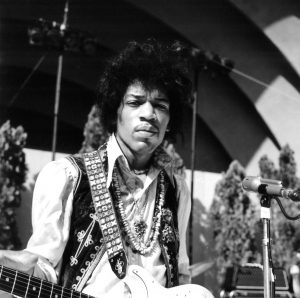
August 18, 1967, Hollywood Bowl, afternoon rehearsals, Hollywood, CA
Photo: Brian T. Colvil / © Authentic Hendrix, LLC
This live album documents their triumphant Los Angeles concert held a few weeks before Electric Ladyland was released. The recently discovered two-track soundboard recording captures the energy that had the audience in such a frenzy that many concert goers jumped into the reflecting pool that separated the bandstand from the seats.
Live At the Hollywood Bowl 9/14/68 includes selections from all three Experience albums, as well as a cover of Cream’s smash hit “Sunshine of Your Love.” The accompanying book is filled with unpublished photos that follow the band at the Bowl, from afternoon rehearsal, to backstage to the performance itself.
I remember this concert but I couldn’t afford a ticket at the time. I loitered around Hollywood Blvd. and Highland Ave. talking to concert-goers and friends from Fairfax High School on the way to their encounter with destiny.
But I did make sure in 1969 to see the Jimi Experience in Devonshire Downs at the Newport ’69 Pop Festival.
In 2018 I spoke to a few veterans about the Hollywood Bowl experience. They shared the memories of a monumental moment.
Peter Piper: In February 1968 I bought the Hendrix Shrine Auditorium John Van Hamersveld poster at the Free Press Book store on Fairfax Ave. I had missed Jimi’s concert and was really happy he was coming back to Hollywood in September ’68 to play the Hollywood Bowl.
“I got my tickets at Wallichs Music City. I was living near Washington Blvd. and La Brea Ave. by the Persian Room at the time. At the time my girlfriend Carol went all the way back to Grand Rapids Michigan, and I borrowed money to fly her back to L.A. because that is how much I loved her and wanted to see Jimi with her.
“Surfers in 1968 were really getting into Jimi. His freedom on stage, on records and wardrobe, even his interviews, were like when we were locked in a tube or on a long wave ride.
“In 1966 and ’67 I worked the parking lot at the Old World, The Source and The Galaxy on Sunset, even on occasion The Whisky a Go Go, and even though I loved soul music, Jimi was part of that sonic world, too.
“On the day of the Hendrix Hollywood Bowl show we went to El Segundo in the South Bay, right by El Porto. A guy I grew up with who went to L.A. High School. We smoked some weed and he then handed us these gigantic capsules of mescaline. We took ‘em there. And then drove all the way into Hollywood. I had a Falcon station wagon. The AM radio barely worked. We are really excited to see Jimi and The Vanilla Fudge.
“We got to the Hollywood Bowl. The parking attendant for some reason, let us park at the very bottom of one of the lots near the back entrance but near a hill. Our car blocked everyone who parked behind us.
“We got to our seats. I paid $20.00 each and just above the box seats. A good location to see Jimi. I had my opera glasses. We saw Eire Apparent and Soft Machine. Then there was an intermission.
“One guy in our row had a stack of 50 joints with a rubber band around them. He was from Cheviot Hills. A friend of my brother who went to school with us. I was in a surf club, The North Coast Surfing Association with him.
“Carol and I had not come on yet to the mescaline. Vanilla Fudge was incredible. That was the big toss-up who would play better, them or Jimi. On their recordings they sounded tinny. But live they sounded so much better. The sound mix was terrific. The organist sang lead and used his hands to conduct the other musicians like Carmen Dragon when he had the orchestra at the Hollywood Bowl. The Vanilla Fudge put on a good show.
“And then Jimi comes out in a white suit, white boots and a purple scarf. It was other worldly. The roadies were adjusting all the amps when he was doing the first song. By the second song the whole place really started feeling the vibe. And there was the pond in front of the stage so it had a waterfall aspect to it. Like a dam broke. Carol and I were really into the groove as people started going toward the front. And she started crying. ‘If he tries to leave they are gonna riot.’ (laughs).
“I see one guy in the front that jumped into the pond. I later find out he went to Oakwood School with my brother. Then other people dive into the water. I’m a surfer. You do not mix water and electronics and the chance of any water splashing onto the stage.
“I will say, it was only during watching the concert that it became really obvious to me that it was the Jimi Hendrix Experience. ‘Jimi, Mitch and Noel’ as deejay Jimmy Rabbit would always announce them.
“My father, Ralph Piper was a piano player, known for having the best left hand in the business. He did jobs with Stan Kenton, Jack and Cubby Teagarden. Before I was born The Dorsey Brothers jammed at our house with my father. And I knew and understood jazz trios. Jimi and the cats were like ‘a jazz trio meets Cream.’
“Half way into the set we came onto the mescaline. Carol and I left the concert just beaming. Then the real adventure started…
“We had no concept of where our car was. I was just flashing that we had to find this one long line of cars as we were the car at the entrance. We kept walking around the Hollywood Bowl and could not locate our wheels. It must have been 90 minutes. Basically all the cars and buses were pretty much gone and we’re alone in front of the Hollywood Bowl marquee.
“I found one person with a flash light and asked for some help. He told me there was a line of cars on the other side. He had a walkie-talkie. So we go to the other side and there are a few people sort of angry as we needed to move our car to create a path for them to leave so they could get to Highland Ave. And here is a van parked at the top of the hill by the back gate pretty close to us and music was playing. The only vehicle near us.
“We walked to the van and these two people come out and walking to the van are Jimi and this girl. A beautiful black chick. And they are heading in our direction. And Jimi is kind of half-hiding behind her. ‘Hey, how did you like the show?’ We didn’t shake hands, but I said ‘you are the greatest, man. Nobody like you.’
“We were buzzed and feeling good. As far as we were concerned, the night was still young and I suggested we go back to Hollywood and over to Shelley’s Manne-Hole on Cahuenga to see Mose Allison. The day before I had turned age 21 but did not have an ID on me. The bartender let us in anyway and said we could come in to check it out and listen to Mose for his opening song. Then Mose walked in through the front door after his first break. We talked for a bit and I mentioned a jingle, a radio spot he did in 1960 for radio station KNOB-FM in Long Beach.
“Welcome to Hollywood during September of 1968.”
Rodney Bingenheimer: I went to the concert with photographer Ed Caraeff. We had seen Jimi and the group in June at the Monterey International Pop Festival in 1967. During July Ed and I took Jimi to a party at John and Michelle Phillips house in Bel-Air. During 1968 I would see Jimi around Hollywood. He did some recording at TTG studios. I cruised with Jimi once in his yellow Corvette Stingray to Gold Star studio when the Cake was recording.
“At the Hollywood Bowl we got all access passes. Went to the sound check, hung out backstage and watched the show from the stage wings. Amazing. People jumping into the water. Jimi was a very cool guy and very
“Loads of fans jumped in the pond waterfall at the Hollywood Bowl before Pat, Brian and I did. When Jimi started playing ‘Fire’ we couldn’t contain ourselves! Then Brian lost his keys and we had to hitch hike home in wet clothes!”
“My brother Moshe gave me Electric Ladyland on wax for my 15th birthday, during the height of L.A.’s Paisley Underground, when I was stuck on The Byrds, Love, and The Seeds,” recollected writer and author Daniel Weizmann. “He said, ‘You need this, Danny, since I know you’ll never buy anything this cool for yourself.’ Typical older brother ribbing. Of course, he was right.
“Ray Manzarek of The Doors once said something to the effect of, ‘Once you saw where you stood in relation to eternity, making three minute pop songs for AM radio seemed kind of inconsequential.
“Who besides Jimi embodied that ‘relation to eternity’ with such force? With every parry and thrust of his guitar, he reaches for an otherworldly plane–but for real.
“He’s almost like the sonic equivalent of Dylan’s wordplay: reckless, volcanic, passionate to the point of self-immolation, and totally at sail on the wildest stormiest molten currents of the unconscious. No boundaries. And like Dylan, he isn’t just doing a puppet show to prove a point or something–the necessity of the spiritual quest is really believed by the questioner.
“I kind of see the sixties as Before Jimi and After. I love him for what he brought, but sometimes I lament all he obliterated. I mean, for better or worse, he journeyed off the edge of the flat square world and found that it was round and after that, you could never pretend in two dimensions again.”
(Harvey Kubernik is the author of 15 books, including titles on Leonard Cohen and Neil Young. His 2017 volume, the acclaimed 1967 A Complete Rock History of the Summer of Love was published by Sterling/Barnes and Noble. Inside Cave Hollywood: The Harvey Kubernik Music InnerViews and InterViews Collection, Vol. 1 was published in December 2017, by Cave Hollywood. Kubernik’s The Doors Summer’s Gone was published by Other Cottage Industries in March 2018.
During November 2018 Sterling/Barnes and Noble published Harvey’s book, The Story of The Band From Pig Pink to The Last Waltz, written with brother Kenneth Kubernik.
In November of 2006, Harvey Kubernik was a featured speaker discussing audiotape preservation and archiving at special hearings called by The Library of Congress and held in Hollywood, California).

